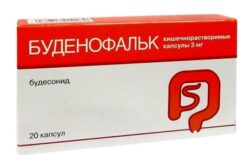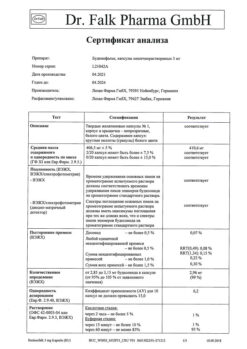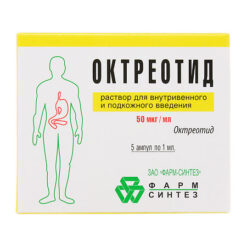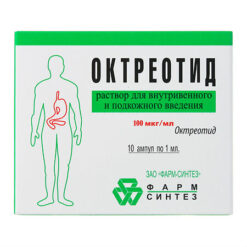No products in the cart.
Budenofalk, rectal dosed foam balloon 2 mg/dose 14 doses
€1.00
Out of stock
(E-mail when Stock is available)
Description
Exacerbation of distal forms of ulcerative colitis (with involvement of the rectum and sigmoid colon).
Active ingredient
Active ingredient
Composition
Composition
1 dose of foam contains:
the active ingredient:
budesonide 2 mg;
excipients:
propylene glycol 600.3 mg,
water 550.93 mg,
p> emulsion wax* 16.8 mg,
macrogoal stearyl ether 16.8 mg,
cetyl alcohol 8.4 mg,
citric acid monohydrate 3.67 mg,
dinatrium edetate dihydrate 1.1 mg,
propellants (at about 2.5 bar: propane 7.24%, n-butane 6.66%, isobutane 86.01%) 83 mg.
* emulsion wax contains cetostearyl alcohol and polysorbate 60.
How to take, the dosage
How to take, the dosage
The drug is used rectally.
Unless otherwise prescribed by the doctor, for adults, once a day (morning or evening). For best results, it is recommended that the drug be given after bowel movement (defecation).
At the time of administration Budenofalk must be at room temperature (20-25 ° C).
1. Place the applicator firmly on the head of the syringe.
2. shake the bottle for 15 seconds to mix the contents.
3. When using for the first time: remove the protective tab from the base of the dispensing head.
4. Rotate the cap so the half round notch on the safety ring is in line with the tip.
5. Place your index finger on the cap and turn the bottle upside down.
6. Push the applicator as far into the rectum as possible. It is best to put your foot on a chair or stool when doing this. To inject the dose of the medicine, press the cap all the way in and slowly release it. Wait 10-15 seconds, then slowly remove the applicator from the rectum.
7. After injecting the foam, remove the applicator and discard it by packing it in a plastic bag. A new applicator should be used for each new dose of product administered.
8. Wash your hands after the procedure. Try not to empty your bowels until the next morning.
The duration of treatment is chosen by the doctor individually, but no more than 6-8 weeks.
Interaction
Interaction
Pharmacodynamic interactions
Cardiac glycosides:
The effects of cardiac glycosides may be enhanced by potassium deficiency.
Diuretics:
Hypokalemia may increase.
Pharmacokinetic interactions
Cytochrome CYP3A (P450) inhibitors such as ketoconazole, ritonavir, troleandomycin, erythromycin, cyclosporine, and grapefruit juice may enhance the effect of glucocorticosteroids.
The cytochrome CYP3A (P450) inducers, such as carbamazepine and rifampicin, may decrease the systemic as well as, local effects of budesonide on intestinal mucosa. In this case, adjustment of budesonide dose is necessary.
An increase in the effects of corticosteroids associated with an increase in their plasma concentrations was observed in women taking estrogens or high doses of combined oral contraceptives. This fact was not observed with low-dose combined oral contraceptives.
The concomitant administration of cimetidine and budesonide may result in clinically insignificant increases in plasma budesonide levels.
Theoretically, interaction with ion-exchange resins that can bind steroids (e.g., cholestyramine) and antacids cannot be excluded. If these drugs are taken concomitantly with Budenofolk, the therapeutic effect of budesonide may be reduced as a result of the interaction.
Special Instructions
Special Instructions
Budenofalc has no effect on hypothalamic-pituitary-adrenal function, but because some budesonide is absorbed into the blood when administered rectally, we cannot completely rule out no effect on this system.
Budesonide has lower blood concentrations when treated with Budenofalc compared to systemic administration, so changing a patient from oral or parenteral budesonide administration may result in symptoms associated with altered systemic steroid levels.
Cetyl alcohol and propylene glycol can cause a local allergic reaction (contact dermatitis).
The product does not contain preservatives.
The bottle is under high pressure. The bottle should not be exposed to sunlight or heated to temperatures above 50 °C. Do not open, puncture, or incinerate empty used bottles. Do not use near open flames or incandescent objects.
Contraindications
Contraindications
Hypersensitivity to budesonide or other drug components, infectious intestinal diseases (bacterial, fungal, amebic, viral infections), liver cirrhosis with signs of portal hypertension (for example, in the terminal stage of primary biliary cirrhosis), childhood age (under 18 years), pregnancy, breastfeeding period.
With caution:
Tuberculosis, arterial hypertension, diabetes mellitus, osteoporosis, gastric and duodenal ulcer, glaucoma, cataracts, and a history of diabetes or glaucoma in the family.
Side effects
Side effects
The following adverse events noted during the use of the drug are categorized according to the following frequency of occurrence: frequently (⥠1/100 to < 1/10), infrequently (⥠1/1000 to < 1/100), rarely (⥠1/10000 to < 1/1000), very rarely (< 1/10000).
Infectious and parasitic diseases
Infrequent: urinary tract infections.
Blood and lymphatic system disorders
Infrequent: anemia, accelerated erythrocyte sedimentation rate, leukocytosis.
Metabolic and nutrition disorders
Infrequent: increased appetite.
Mental disorders
Infrequent: insomnia.
Nervous system disorders
Infrequent: headache, dizziness, disorders of smell perception.
Vascular disorders
Infrequent: increase in blood pressure.
Gastrointestinal disorders
Infrequent: nausea, abdominal pain, dyspepsia, flatulence, abdominal paresthesia, anal fissures, frequent requests for defecation, rectal bleeding, hemorrhoids, aphthous stomatitis.
Hepatic and biliary tract disorders
Infrequent: increased activity of liver enzymes (ACT and ALT), cholestasis.
Skin and subcutaneous tissue disorders
Infrequent: inflammation of sebaceous glands (acne), increased sweating.
Laboratory and instrumental data
Infrequent: increase in amylase (pancreatic enzyme) activity, changes in cortisol (hormone produced by adrenal cortex).
General disorders and disorders at the site of administration
Often: burning sensation and pain in the rectum.
Infrequent: asthenia, weight gain.
When using the drug Budenofalc, side effects common to all glucocorticosteroids may also occur, due to both local and systemic effects of the drug on the human body. These side effects depend on the dose, duration of therapy, concomitant or prior treatment with other glucocorticoid drugs, and individual sensitivity.
Disorders of the immune system: weakening of the body’s defenses and, therefore, an increased risk of infection.
Metabolic and nutritional disorders: Cushing’s syndrome.
Mental disorders: depression, irritability, euphoria.
Visual organ disorders: glaucoma, cataracts.
Nervous system disorders: edema of the optic disk.
Vascular disorders: increased blood pressure, increased risk of thrombosis, vasculitis (with abrupt withdrawal of the drug after long-term treatment).
Gastrointestinal disorders: complaints of abdominal discomfort, duodenal ulcer, pancreatitis, constipation.
Skin and subcutaneous tissue disorders: allergic exanthema, stricture, petechial and ecchymatous hemorrhages, delayed wound healing, contact dermatitis.
Muscular and connective tissue disorders: aseptic necrosis of the femoral and humerus heads, diffuse muscle pain, weakness, osteoporosis.
General disorders: fatigue, discomfort.
Some of these side effects have been observed in clinical studies only after long-term oral use of budesonide. The risk of side effects caused by the use of budesonide, rectal dosage foam 2 mg/dose, is significantly lower than with systemic glucocorticoid use.
If any of the side effects listed in the instructions worsen or if you notice other side effects not listed in the instructions, tell your doctor.
Overdose
Overdose
No cases of overdose have been found.
In case of overdose symptomatic treatment is administered.
Similarities
Similarities
Additional information
| Manufacturer | Aerosol Service AG, Switzerland |
|---|---|
| Medication form | rectal metered foam |
| Brand | Aerosol Service AG |
Other forms…
Related products
Buy Budenofalk, rectal dosed foam balloon 2 mg/dose 14 doses with delivery to USA, UK, Europe and over 120 other countries.














